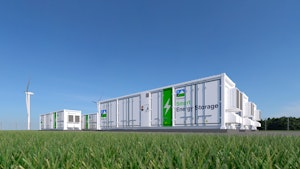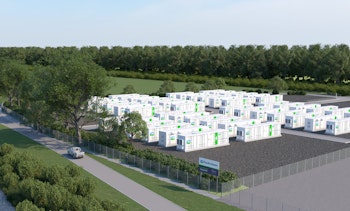The UK’s attractiveness for clean energy investment has been on the rise in recent years. As of 2021, the nation ranked fourth globally on EY’s Renewable Energy Country Attractiveness Index, ahead of low-carbon energy leaders France, Australia and Germany.
That attractiveness for investment has only increased in 2022 with the publication of the British energy security strategy, which builds on the government’s ‘Net zero strategy’ and ‘Ten-point plan for a green industrial revolution’ to unlock £100 billion in private investment.
Battery storage will be a key part of the UK’s energy future—and is already a massive opportunity for investors. In 2021, the market grew by 70% in deployment terms and the pipeline of projects had reached 27 GW at the end of the year.

Batteries are a key facilitator of high renewable energy generation and with the UK Government accelerating its ambitions towards offshore wind in its recently published energy security strategy, the role of storage will become increasingly important.
The pipeline for energy storage in the UK is already bigger than the pipeline for offshore wind. And energy storage represents a much more bankable option for investors. Consider the following:
- New renewable energy plants usually require grid connections and civil works which can further add to the timeline and risk profile of projects. Batteries, in contrast, can avoid the need for grid strengthening and thus complement renewable plants and the grid.
- Wind and solar plants only make money when they are producing energy and may require government-backed contracts for difference for viability. Batteries can play in multiple markets simultaneously and don’t need government support to make money.
- Wind and solar plants require vast areas of land or sea and face tortuous consenting processes. Batteries can be installed in almost any commercial or industrial site, simplifying the permitting process.
From an investor’s perspective, the most attractive feature of battery projects is that these are long-lasting infrastructure assets that meet environmental, social and corporate governance criteria while offering high rates of return and low investment risk.
Risks are reduced because batteries derive revenues from multiple UK energy markets, including:
- National Grid ESO capacity markets
- Day-ahead energy auctions
- Intraday trading markets
- Balancing Mechanism
- Spot market trading
- Ancillary services
Battery projects are unique infrastructure assets because of their ability to stack revenues from different markets.
A single battery system can make money from intraday energy trading, Balancing Mechanism markets, ancillary services such as Dynamic Containment and more—often in a single day.

In the UK, we estimate that a battery system offering wholesale optimisation and ancillary services and operating in the Triads and Capacity Market should generate approximately £59 per kilowatt of capacity in base gross revenues per annum.
Adding further applications, such as participation in the National Grid Balancing Mechanism, could deliver an additional £32 per kilowatt, pushing returns to £91 per kilowatt.
For a typical 100 MW battery project, that equates to around £9 million revenue a year—and the asset could have a lifetime of more than 25 years.
Despite this obvious financial opportunity, investors may remain wary of energy storage because of the technical complexity of projects. What if there was a way to reduce the risk by investing with experienced technical partners with robust financial backing?
This is the case with a 100 MW, 100 MWh battery energy storage system we are building at the Richborough Energy Park in Kent. Richborough is typical of a growing number of energy infrastructure opportunities in the UK as the country sets a course for net zero emissions.
Originally the site of a coal-fired plant, Richborough’s thermal power station was demolished in 2012 and its grid connection is now used to bring energy ashore from Thanet Wind Farm, formerly the world’s largest offshore wind project.
Located optimally where energy generation comes onshore and servicing the high demand centre of London and the Southeast, the site benefits from incentive payments from the transmission network.

Richborough also acts as a landing point for the 1 GW Nemo Link interconnector to Belgium, which entered commercial service in 2019.
In 2021, Pacific Green confirmed it had signed an offer letter from Close Leasing Limited to secure £28 million in debt finance for the development of a 100 MW battery system at Richborough Energy Park.
The project is due to go live in 2023 with a 35-year operational horizon, incorporating battery augmentations every 10 years. For investors, it offers the assurance of working with a range of highly reputable partners.
The project originator is Tupa Energy, which specialises in developing utility-scale battery storage, solar generation and rapid electric vehicle charging infrastructure. The project comes with a 95-year land lease option, planning permission and connection agreements.
We have created a special-purpose vehicle, Richborough Energy Park Limited (REP), to carry out the work. Batteries will be sourced through a framework agreement with Shanghai Electric Gotion New Energy Technology.
The offtaker for the project is Shell, which is also providing battery optimisation through its Limejump subsidiary’s market-leading trading team and machine learning-based intelligent dispatch platform.
Project costs are estimated to be less than £43 million, £28 million of which will be financed through senior-term debt.
Pacific Green Energy Storage has created a bespoke opportunity for an investor to invest the balance of the construction costs through a preference share structure providing downside protection, preferred returns and a share of the upside.
And Richborough Energy Park is just the first in a series of energy park opportunities being offered by Pacific Green Energy Storage (UK).
Thanks to an exclusive agreement with Tupa Energy, we are due to initiate development of 1.1 GW of capacity by the end of 2025, or around 10% of all the battery capacity that the UK might end up installing this decade. Clearly, energy parks are a big opportunity for UK investors.
And for peace of mind when investing in them, there is no better partner than Pacific Green. To find out more about working with us to benefit from the tremendous opportunities awaiting investors in the UK energy parks, contact us now.
Publish date: 09 June, 2022